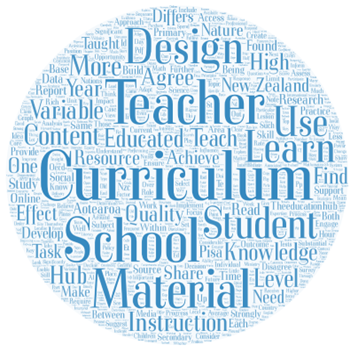Hosted by Nina Hood – Education Counts
Date: 05/09/23

The panel
- Associate Professor Bronwyn Wood – Victoria University of Wellington
- Pauline Waiti – Education consultant at Ahu Whakamua Limited
- Barbara Ala’alatoa – past principal of Sylvia Park School
- Christine Parkinson & Seth Davies – Rangitoto College Auckland
The variable nature of curriculum design and instructional materials in Aotearoa New Zealand schools refers to the fact that there is a significant degree of variation in how the curriculum is interpreted and implemented by teachers across the country, and in the selection and use of instructional materials.
This variability is influenced by a range of factors, including:
- Teacher autonomy: Teachers in New Zealand have a high degree of autonomy in how they design and implement the curriculum. This means that there is no single “correct” way to teach the curriculum, and teachers are free to adapt it to meet the needs of their students and their own teaching styles.
- School context: Schools in New Zealand vary widely in terms of their size, location, student demographics, and resources. This means that what works well in one school may not work well in another. There are also continuous challenges around professional development and workload.
- Teacher expertise: Teachers have different levels of expertise and experience in curriculum design and instructional materials. This can lead to variability in the quality and effectiveness of rich curriculum implementation across schools. Are our school leaders up for this challenge? Leadership does matter by providing direction for their schools. Teachers are teaching but have not been involved in curriculum design. How many have even studied curriculum design in training programmes let alone have capability in quality planning?
- Availability of resources: Schools in New Zealand have varying levels of access to resources, such as textbooks, digital technologies, and professional development opportunities. This can also contribute to variability in curriculum design and implementation. Any resource brought in must enhance the curriculum and not replace it.
The variability in curriculum design and instructional materials has both positive and negative implications. On the one hand, it allows teachers to be responsive to the needs of their students and to develop innovative and engaging teaching approaches. On the other hand, it can lead to inequity in student outcomes, as students in some schools may have access to a more rigorous and high-quality curriculum than students in other schools.
The New Zealand Ministry of Education is working to address the issue of variability in curriculum design and instructional materials. For example, the Ministry has developed a new curriculum document, The New Zealand Curriculum, Te Mataiaho, which provides clearer guidance to teachers on what to teach and how to teach it. The Ministry is also investing in professional development opportunities to help teachers improve their curriculum design and instructional skills. These include the ‘Common Practice Model’ They also include four teacher only days in 2023 and in 2024 and have asked schools within the same areas to coordinate the same dates so that there are minimal disruptions for parents and whānau. In addition there is now a National Curriculum Centre with Karen Spence as Chief Advisor, Strategy & Integration in Te Poutāhū National Curriculum Centre. Te Mataiaho draws deliberate attention to its histories and across the learning areas, and it is no longer appropriate to teach bits of knowledge.
Despite the efforts of the Ministry, variability in curriculum design and instructional materials is likely to remain a feature of the New Zealand education system. Teachers and leaders must know curriculum design because curriculum design must be carried out by knowledgeable practitioners. One key way of doing this is ensuring an understanding of the Common Practice Model. The school leader’s key job is to lead learning. The curriculum does not operate on its own. We must continue to share our teaching practice with a focus on explicit teaching. Schools must ensure optimal conditions for learning with availability of resources.However, by understanding the factors that contribute to this variability, schools and teachers can work together to take steps to mitigate its negative effects and ensure that students have access to a high-quality rich curriculum that reaches all students.
Within our curriculum design continually ask:
- Whose voice can we not hear? As a multicultural nation sometimes there is excessive emphasis across all learning areas on one form of traditional knowledge. The excessive emphasis also includes too much content available in that one form of knowledge.
- How do we ensure that everyone in our community feels a sense of ownership for our local curriculum?
- How do we build partnerships with parents, whänau, iwi and hapu, and the wider community?
- How do we ensure that we are being inclusive and culturally responsive to our tamariki/mokopuna, parents and whanau?
- How do we make use of local and community resources and connections? Examples of this are cultural connections, businesses, community resources, professional relationships, and service providers
- Is the design pushing analogue thinking in a digital world? A good example of this is downloaded work from “busywork.com” and the “Twinklification” of our classrooms.
From this webinar I spent time reading around the ‘Common Practice Model’ and strongly suggest all educators do the same.
Thank you Nina for providing this resource and webinar to keep the kórero alive.
